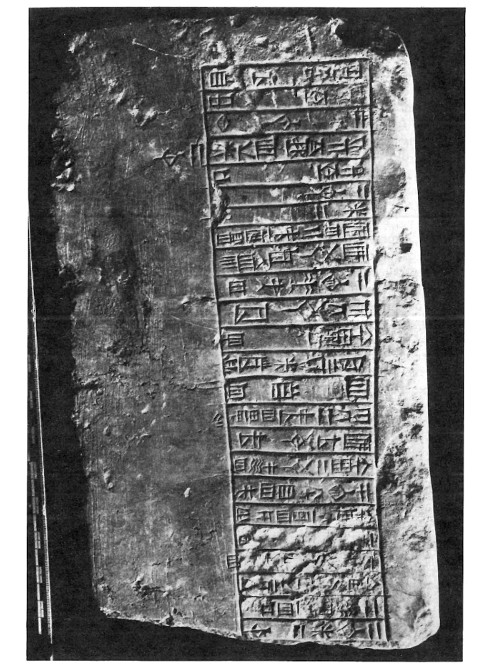Šalim-aḫum
Šalim-aḫum was the son of Puzur-Aššur I and the father of Ilu-šūma; he was the second ruler of the so-called "Puzur-Aššur Dynasty" and the thirty-first ruler of Aššur. Since only one inscription of his is presently attested, very little is known of Šalim-aḫum's reign, apart from few pieces of information about his building activities in the area of the Aššur temple. In the Assyrian King List [/riao/kinglists/assyriankinglist/index.html] (AKL), he is mentioned as one the independent rulers of Aššur "[who(se names) appear on] bricks, (but) whose eponyms are not known [/riao/kinglists/assyriankinglist/assyriankinglist/index.html#Unknown eponymies]" and, therefore, the length of his reign is not known. Scholars assume that Šalim-aḫum was in power around the end of the 21st century and the beginning of the 20th century BCE. As the AKL implies, and confirmed by the other extant sources, the eponym system (the Assyrian method of dating), was established under Šalim-aḫum's grandson Erišum I.
Bibliography
Browse the RIA 1 Corpus [/riao/ria1/pager/]
1
An alabaster block with an inscription of Šalim-aḫum was found in a room in the east corner of the main courtyard, in the oldest stone foundation; bricks stamped/inscribed with texts of his grandson Erišum I were also found there (Heller and Andrae 1955, 14-16). The object is known only from a single excavation photograph and a hand-drawn copy published by Meissner. The Akkadian inscription is engraved in "mirror writing," an explanation for which still lacks common scholarly consensus. There are a few other examples of this highly unusual style of inscribing Mesopotamian monumental texts (Farber 1991, 13 note 4). In the corpus of Assyrian inscriptions, one notes in particular Ikūnum text no. 2 [/riao/ria1/Q005640/], which has signs that are written in the normal way, but the order of its lines is reversed; that is, the inscription is read from bottom to top, rather than the expected top to bottom. A different style of mirror writing is that of (cylinder and stamp) seals, which are engraved with images and inscriptions as they were intended to be seen; a negative, (i.e. a reverse) of the positive carving was impressed in clay when these seals were used and thus the impressed text was in mirror writing. For example, see the contemporary Erišum I text no. 17 [/riao/ria1/Q005637/], which was found at Kaneš/Kültepe (see Meyer in Preusser, Paläste p. 11 n. 39), the later Aššurnasirpal II text [/riao/ria4/texts10012007/index.html#ashurnasirpal22005] nos. 2005-6 [/riao/ria4/Q004603,Q004604/], and Adad-nārāri III text [/riao/ria5/adadnarariiii/texts121/index.html#adadnarari320] no. 20 [/riao/ria5/Q004768/].

VA 08835. Farber 1991, p. 14
W. Farber (1991, 13) has suggested that the present text had not originally been intended to be engraved in mirror writing, but rather had been copied directly from a seal (in its usual negative form) by a stone mason "who did not know very much about writing, as would also be indicated by the crude sign forms of the text." There is no real evidence to support Farber's proposal and one should not dismiss the possibility that this inscription of Šalim-ahum was purposely engraved in mirror writing; this may have had something to do with the nature of the monument, as well as its intended public (whether human or divine). Old Assyrian positive seals, with their mirrored impressions, may have served as possible models for the realization of a 'true copy' of texts. A figurative motif, as the available sources seem to indicate, proved to be unsuccessful.
Given its state of preservation, the text is difficult to interpret. Šalim-ahum claims that the god Aššur contacted him in a dream and requested that he build a temple. In response, he constructed a temple to the god Dagān, a House of the Beer Vats and (its?) storage area. B. Landsberger and K. Balkan (1950, 239-40) suggest that the House of the Beer Vats should be regarded as the name of a chapel in the Aššur temple which was shared by the gods Enlil, Dagān, and Bēl-labriya (among others), and which was known in later periods as the "Kitchen"; they also propose that this part of the temple was the place that Erišum I referred to as the "House of the Twins," that is, the spot where two ceremonial beer vats were placed (text nos. 1, 11, and 13 [/riao/Q005621,Q005631,Q005633/]).
Access the composite text [/riao/Q005618/] of Šalim-aḫum 1.
Bibliography
Nathan Morello
Nathan Morello, 'Šalim-aḫum', RIA 1: Inscriptions from the Origins of Assyria to Arik-dīn-ili, The RIA Project, 2023 [http://oracc.org/earlybeginnings/puzurashurdynasty/shalimahum/]